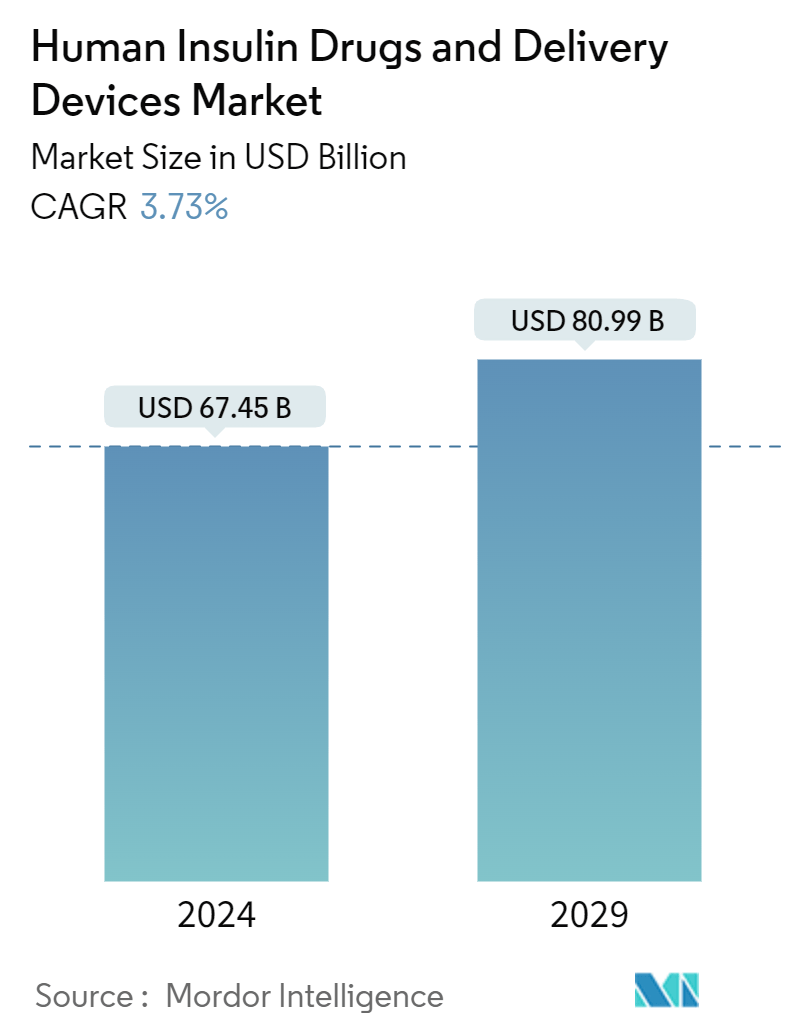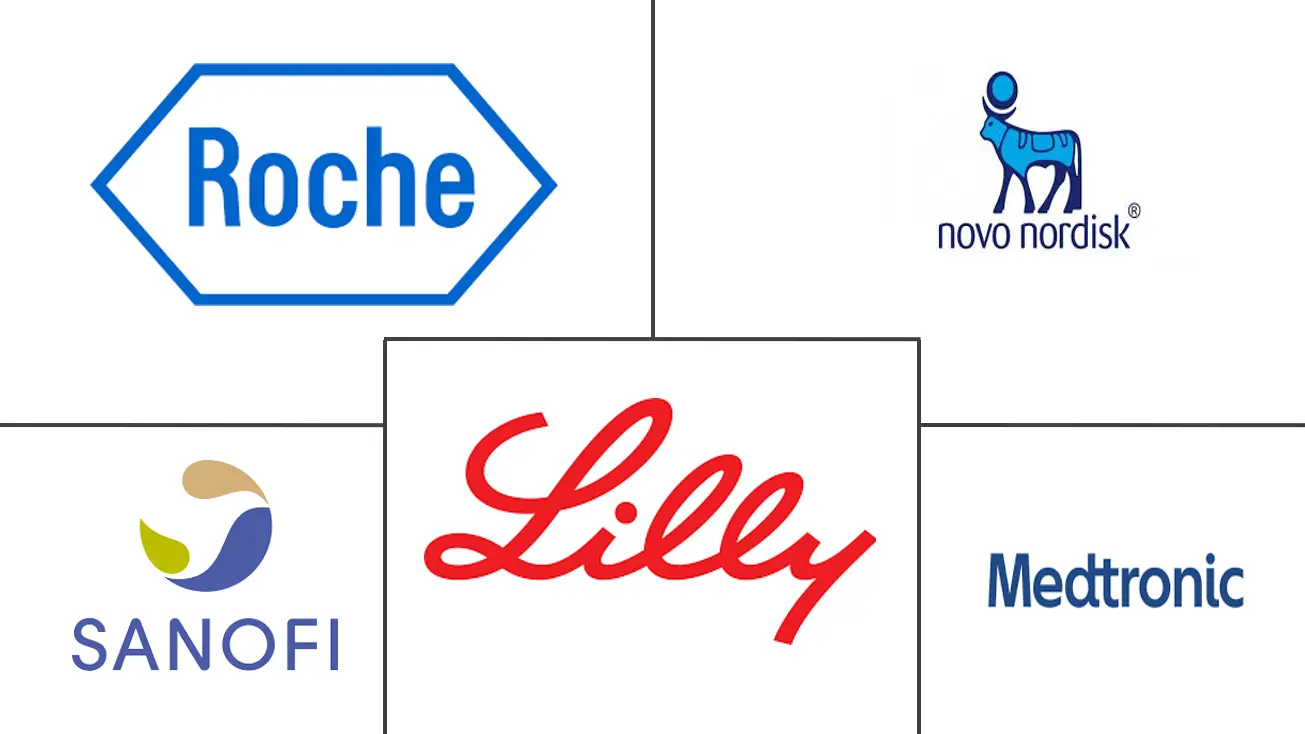Market Size of Human Insulin Drugs And Delivery Devices Industry

| Study Period | 2018 - 2029 |
| Market Size (2024) | USD 67.45 Billion |
| Market Size (2029) | USD 80.99 Billion |
| CAGR (2024 - 2029) | 3.73 % |
| Fastest Growing Market | Asia Pacific |
| Largest Market | North America |
Major Players
*Disclaimer: Major Players sorted in no particular order |
Human Insulin Drug and Delivery Device Market Analysis
The Human Insulin Drugs And Delivery Devices Market size is estimated at USD 67.45 billion in 2024, and is expected to reach USD 80.99 billion by 2029, growing at a CAGR of 3.73% during the forecast period (2024-2029).
Diabetes is generally considered a lifestyle-related disease. Over time, with the increase in population around the world, the incidences of the disease have increased outrageously. Approximately 100 million people around the world need insulin, including all the people suffering from Type 1 diabetes and between 10-25% of people with Type 2 diabetes. Although insulin has been used in the treatment of diabetes for over 90 years, globally, more than half of those who need insulin today still cannot afford and access it.
The global increase in the population affected by type 1 diabetes has spurred significant growth in the insulin drugs and device market. Type 1 diabetes, characterized by the body's inability to produce insulin, affects millions of individuals worldwide, and its prevalence is on the rise. Factors such as sedentary lifestyles, unhealthy dietary habits, and genetic predispositions contribute to this upward trend.
With the expanding diabetic population, there is a growing demand for insulin medications and delivery devices to manage the condition effectively. Insulin remains the cornerstone of treatment for type 1 diabetes, as well as for some individuals with type 2 diabetes who require insulin therapy. As a result, pharmaceutical companies are investing in research and development to innovate new insulin formulations and delivery systems that offer improved efficacy, convenience, and safety for patients.
Moreover, advancements in technology have led to the development of insulin pumps, continuous glucose monitoring (CGM) systems, and artificial pancreas devices, which provide more precise insulin dosing and better glycemic control. These innovations have transformed diabetes management, empowering patients to lead more flexible and active lifestyles while reducing the risk of hypoglycemia and other complications.
The increasing prevalence of type 1 diabetes, coupled with advancements in insulin therapies and delivery devices, is expected to continue driving the growth of the insulin drugs and device market in the years to come. This growth presents opportunities for pharmaceutical companies, medical device manufacturers, and healthcare providers to collaborate in delivering innovative solutions that improve the quality of life for individuals living with diabetes.
Insulin Drugs and delivery devices are necessary for type-1 diabetes patients because their body doesn't produce insulin internally, type-2 diabetes patients also need insulin, particularly those who have difficulty controlling their diabetes with oral medications.
Human Insulin Drug and Delivery Device Industry Segmentation
The hormone class of drugs includes human insulin. In place of the insulin that the body ordinarily produces, human insulin is used. It assists in the movement of blood sugar into different bodily tissues, where it is used as an energy source. It also prevents the liver from generating additional sugar. The human insulin drug and delivery device market is segmented by type, device type, and geography. The report offers the value (in USD) and volume (in units) for the above segments.
| By Drug | |||||||
| |||||||
| |||||||
| |||||||
| |||||||
|
| By Device | |||||
| |||||
| |||||
| Insulin Syringes | |||||
| Insulin Jet Injectors |
| Geography | |||||||||||||
| |||||||||||||
| |||||||||||||
| |||||||||||||
| |||||||||||||
|
Human Insulin Drugs And Delivery Devices Market Size Summary
The human insulin drugs and delivery devices market is poised for steady growth, driven by the increasing prevalence of diabetes globally. As diabetes becomes more widespread, particularly type 1 diabetes, the demand for insulin medications and delivery systems is on the rise. This demand is further fueled by lifestyle changes and genetic factors contributing to the disease's prevalence. Despite insulin being a cornerstone treatment for diabetes for over nine decades, access and affordability remain significant challenges, with a substantial portion of the population still unable to obtain necessary insulin. The market is characterized by ongoing research and development efforts aimed at innovating insulin formulations and delivery devices, such as insulin pumps and continuous glucose monitoring systems, which enhance patient care and lifestyle flexibility.
North America leads the market, despite high insulin prices, due to the lack of alternative treatments and the ongoing need for insulin among diabetic patients. The market is highly consolidated, with major players like Novo Nordisk, Sanofi, and Eli Lilly dominating the landscape. Recent collaborations and advancements, such as the development of automated insulin dosing systems, highlight the industry's focus on improving treatment efficacy and patient outcomes. The introduction of biosimilar insulin products is expected to alleviate some cost burdens, potentially expanding access to more patients. As the market continues to evolve, opportunities for innovation and collaboration among pharmaceutical companies, medical device manufacturers, and healthcare providers are expected to drive further growth and improve the quality of life for individuals with diabetes.
Human Insulin Drugs And Delivery Devices Market Size - Table of Contents
-
1. MARKET DYNAMICS
-
1.1 Market Overview
-
1.2 Market Drivers
-
1.3 Market Restraints
-
1.4 Industry Attractiveness - Porter's Five Forces Analysis
-
1.4.1 Threat of New Entrants
-
1.4.2 Bargaining Power of Buyers/Consumers
-
1.4.3 Bargaining Power of Suppliers
-
1.4.4 Threat of Substitute Products
-
1.4.5 Intensity of Competitive Rivalry
-
-
-
2. MARKET SEGMENTATION
-
2.1 By Drug
-
2.1.1 Basal or Long Acting Insulins
-
2.1.1.1 Lantus (Insulin glargine)
-
2.1.1.2 Levemir (Insulin detemir)
-
2.1.1.3 Tresiba (Insulin degludec)
-
2.1.1.4 Toujeo (Insulin glargine)
-
2.1.1.5 Basaglar (Insulin glargine)
-
-
2.1.2 Bolus or Fast Acting Insulins
-
2.1.2.1 NovoRapid/Novolog (Insulin aspart)
-
2.1.2.2 Humalog (Insulin lispro)
-
2.1.2.3 Apidra (Insulin glulisine)
-
2.1.2.4 FIASP (Insulin aspart)
-
2.1.2.5 Admelog (Insulin lispro Sanofi)
-
-
2.1.3 Traditional Human Insulins
-
2.1.3.1 Novolin/Mixtard/Actrapid/Insulatard
-
2.1.3.2 Humulin
-
2.1.3.3 Insuman
-
-
2.1.4 Combination Insulins
-
2.1.4.1 NovoMix (Biphasic Insulin aspart)
-
2.1.4.2 Ryzodeg (Insulin degludec and Insulin aspart)
-
2.1.4.3 Xultophy (Insulin degludec and Liraglutide)
-
2.1.4.4 Soliqua/Suliqua (Insulin glargine and Lixisenatide)
-
-
2.1.5 Biosimilar Insulins
-
2.1.5.1 Insulin glargine biosimilars
-
2.1.5.2 Human insulin biosimilars
-
-
-
2.2 By Device
-
2.2.1 Insulin Pumps
-
2.2.1.1 Insulin Pump Devices
-
2.2.1.2 Insulin Pump Reservoirs
-
2.2.1.3 Insulin Infusion sets
-
-
2.2.2 Insulin Pens
-
2.2.2.1 Cartridges in reusable pens
-
2.2.2.2 Disposable insulin pens
-
-
2.2.3 Insulin Syringes
-
2.2.4 Insulin Jet Injectors
-
-
2.3 Geography
-
2.3.1 North America
-
2.3.1.1 United States
-
2.3.1.2 Canada
-
2.3.1.3 Rest of North America
-
-
2.3.2 Europe
-
2.3.2.1 Germany
-
2.3.2.2 United Kingdom
-
2.3.2.3 France
-
2.3.2.4 Russia
-
2.3.2.5 Spain
-
2.3.2.6 Italy
-
2.3.2.7 Rest of Europe
-
-
2.3.3 Asia-Pacific
-
2.3.3.1 Australia
-
2.3.3.2 India
-
2.3.3.3 China
-
2.3.3.4 Japan
-
2.3.3.5 Malaysia
-
2.3.3.6 South Korea
-
2.3.3.7 Thailand
-
2.3.3.8 Philippines
-
2.3.3.9 Vietnam
-
2.3.3.10 Indonesia
-
2.3.3.11 Rest of the Asia-Pacific
-
-
2.3.4 Latin America
-
2.3.4.1 Brazil
-
2.3.4.2 Mexico
-
2.3.4.3 Rest of Latin America
-
-
2.3.5 Middle-East and Africa
-
2.3.5.1 Saudi Arabia
-
2.3.5.2 Iran
-
2.3.5.3 Egypt
-
2.3.5.4 Oman
-
2.3.5.5 South Africa
-
2.3.5.6 Rest of the Middle-East and Africa
-
-
-
Human Insulin Drugs And Delivery Devices Market Size FAQs
How big is the Human Insulin Drugs And Delivery Devices Market?
The Human Insulin Drugs And Delivery Devices Market size is expected to reach USD 67.45 billion in 2024 and grow at a CAGR of 3.73% to reach USD 80.99 billion by 2029.
What is the current Human Insulin Drugs And Delivery Devices Market size?
In 2024, the Human Insulin Drugs And Delivery Devices Market size is expected to reach USD 67.45 billion.

